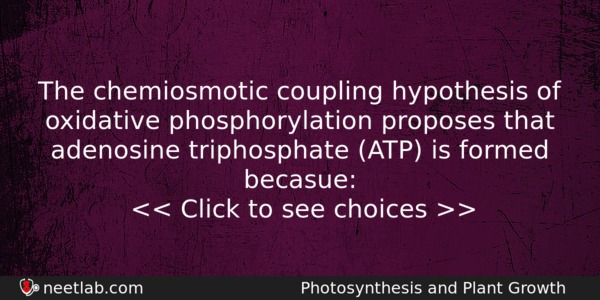| ⇦ | 
| ⇨ |
The chemiosmotic coupling hypothesis of oxidative phosphorylation proposes that adenosine triphosphate (ATP) is formed because:
Options
(a) high energy bonds are formed in mitochondrial proteins.
(b) ADP is pumped out of the matrix into the intermembrane space
(c) a proton gradient forms across the inner membrane
(d) there is a change in the permeability of the inner mitochondrial membrane toward adenosine diphosphate (ADP).
Correct Answer:
a proton gradient forms across the inner membrane
Explanation:
Chemiosmotic theory postulated by the British biochemist Peter Mitchell (1920-22) to explain the formation of ATP in the mitochondrial electron transport chain. As electrons are transferred along the electron carrier system in the inner mitochondrial membrane, hydrogen ions (protons) are actively transported into the space between the inner and outer mitochondrial membranes, which thus contains a higher concentration of protons than the matrix. This creates an electrochemical gradient across the inner membrane, through which protons move back into the matrix.
Related Questions: - Hydrolic enzyme is secreted by
- Protein present in silk fibre is
- Global agreement in specific control strategies to reduce the release of ozone
- The lower most layer of atmosphere in which man and other living organisms exist
- Finding of Miller’s experiment on origin of life has provided evidence for the
Topics: Photosynthesis and Plant Growth
(26)
Subject: Biology
(4253)
Important MCQs Based on Medical Entrance Examinations To Improve Your NEET Score
- Hydrolic enzyme is secreted by
- Protein present in silk fibre is
- Global agreement in specific control strategies to reduce the release of ozone
- The lower most layer of atmosphere in which man and other living organisms exist
- Finding of Miller’s experiment on origin of life has provided evidence for the
Topics: Photosynthesis and Plant Growth (26)
Subject: Biology (4253)
Important MCQs Based on Medical Entrance Examinations To Improve Your NEET Score
18000+ students are using NEETLab to improve their score. What about you?
Solve Previous Year MCQs, Mock Tests, Topicwise Practice Tests, Identify Weak Topics, Formula Flash cards and much more is available in NEETLab Android App to improve your NEET score.
Share this page with your friends

Leave a Reply